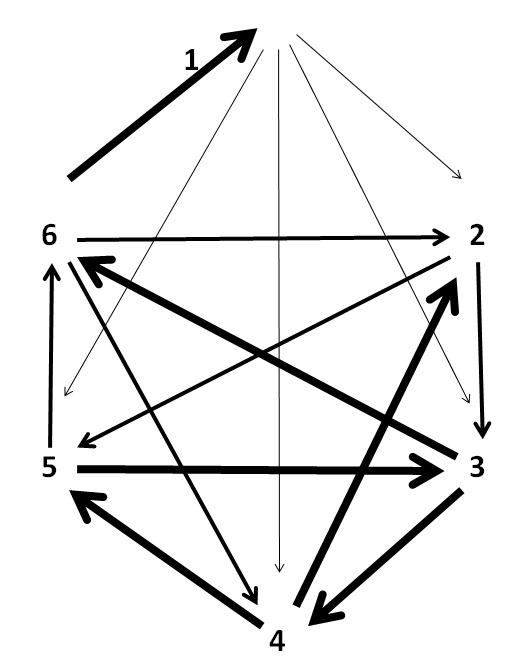Asymmetric Conflict Polygons
Uncertainty in games can come from either building in randomness with dice or shuffled cards or some other sortilege procedure; or from scenarios where players lack information about their opponent’s intentions.
Simultaneous Play often yields a system that models real life scenarios rather well. In this, the players secretly record their intended plays and then all reveal their orders and compare them to see what happens. The game of ‘Diplomacy’ which simulates the political alliances and military balances in Europe from 1900 onwards provides a classic example of a game based on simultaneous play with concealed intentions. Only rarely does peace prevail until 1914.
Some people find the use of dice or some other random mechanism unappealing as it can make the best laid plans come to nothing for no reason except bad luck, and it prevents any detailed analysis of a game afterwards.
The game of Scissors-Paper-Stone, sometimes called ‘Roshambo’, may well originate from the Han Dynasty era in China. It has attracted a considerable amount of study and competitive play, and computer algorithms exist against which humans can play. Although no strategy can consistently beat purely random play, competitions and algorithms remain interesting because few people can consistently play randomly and a good player or algorithm can anticipate the non-random choices of an opponent based on their previous choices.
Nevertheless the game remains rather trivial although the principle has become incorporated into some games to settle combats between pieces, for example in hand to hand conflict, Parry and Thrust beats Lunge, Lunge beats Slash, and Slash beats Parry and Thrust, or something like that. To a very simple approximation circa 1805, Artillery beats Infantry, Infantry beats Cavalry, and Cavalry beats Artillery.
Such a system of conflict resolution leads to a quick and easy type of duelling done with hand gestures, or with cards selected and put forward and then exposed. Yet in its simple form it seems little better than using dice. However by using something a little more sophisticated than a simple symmetrical triangle of outcomes we can create a facility for meaningful tactical choices with some uncertainty of outcome.
Consider the virtues of Asymmetric Conflict Polygons. An Hexagonal one appears below.
In this the six choices can represent any tactic from the exchange of fire between starships to the exchange of spells in a magical duel. The arrows between tactical choices show which choice wins and the weight of the arrow can show by how much. Each player in the duel has six cards marked with the tactical choices and both draw a card and then they simultaneously expose them and find the result. The asymmetries in the chart make some choices more favourable than others, depending on the powers of the pieces involved, however obviously the opponent will appreciate this.
The actual chart shown has the design feature that no choice offers guaranteed immunity from a full hit, but some choices offer greater chances of some kinds of hits.

We could display the information on such a polygon with a simple 6 x 6 chart, however the polygon itself gives a much easier to use representation of the effect of one tactical choice upon another and the opportunities for second guessing the opponent.
Conflict polygons can also model the effects of offensive against defensive tactics where the attacker draws an attack tactic card and the defender draws a defensive tactic card.
In solo play an asymmetric polygon can allow the player to compete with intelligent choices against random choices generated by dice rolls.